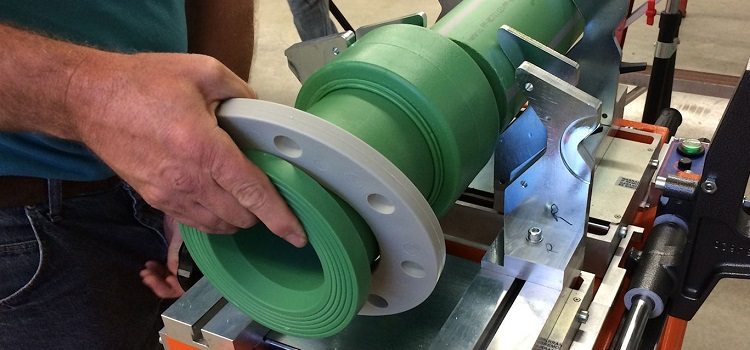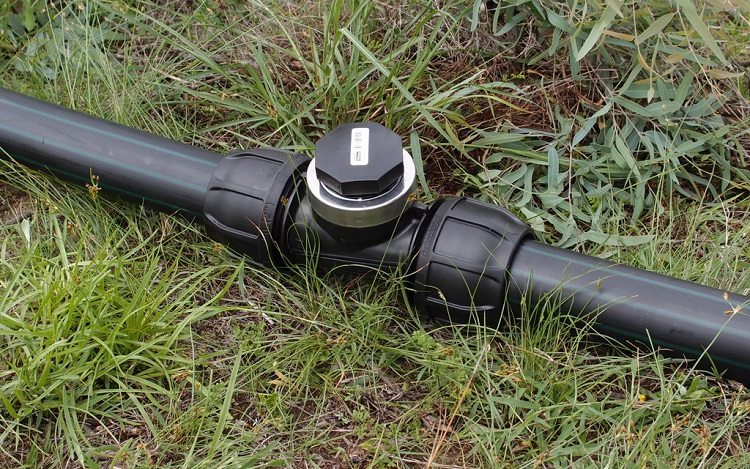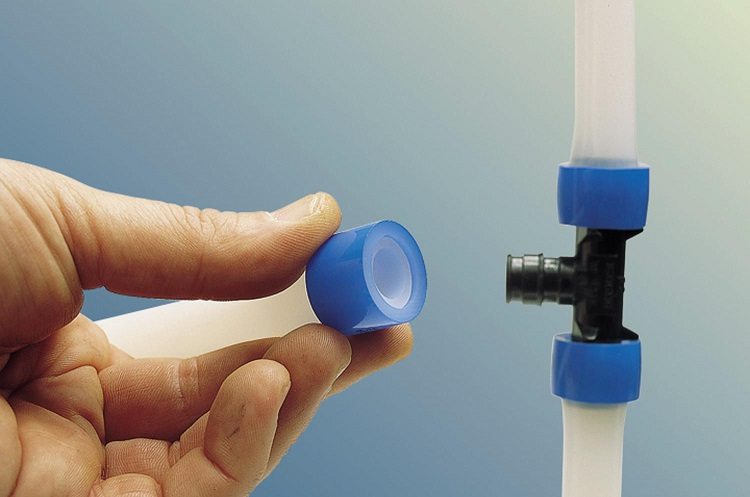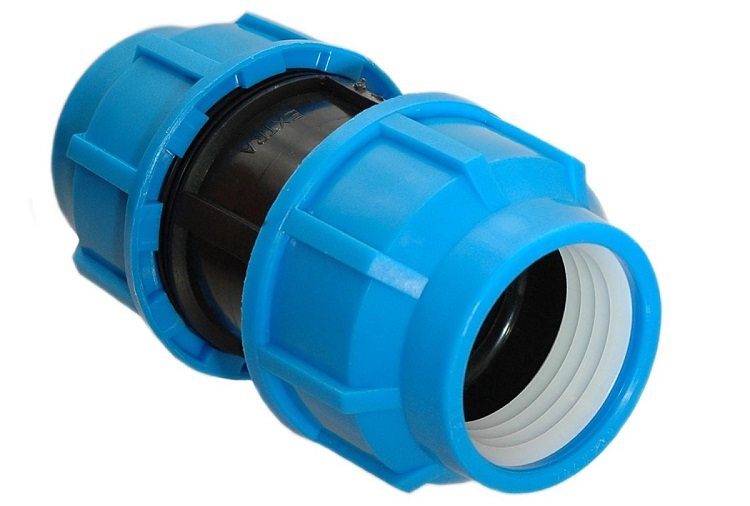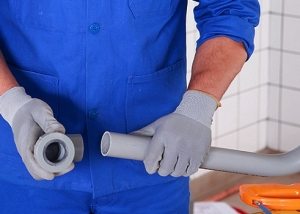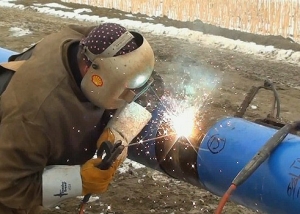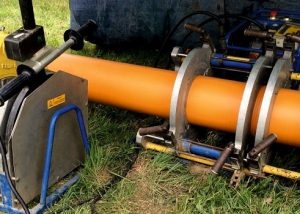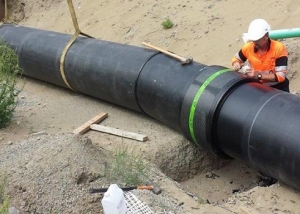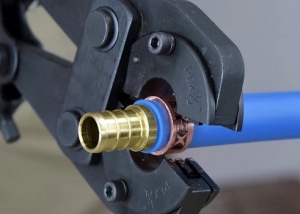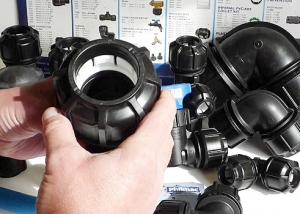Pipes made of low pressure polyethylene (HDPE) are classified as the most popular building materials. Without them, not a single process of erecting modern buildings is dispensed with, where they are used to create water supply and sewage systems. The ease of working with this material, its elasticity and the presence of many methods of connecting polyethylene pipes allows you to pipeline installation fast and at minimal cost.
Content
Product Features
The advantages of HDPE pipes are determined by the presence of the following properties:
- ability to withstand fluctuations in ambient temperature in the range of -60 ≤ T ≤ + 90˚C. Optimum temperature 0 ≤ T ≤40˚С;
- a wide selection of diameters: minimum - 10, maximum -1600 mm. Pipes with a diameter of up to 160 millimeters are supplied in coils or coils with a length of up to 500 m. Products for which the value of this parameter exceeds 160 millimeters are produced only in segments of measured length.
- permissible pressure of the working medium - up to 20 atmospheres;
- resistance to the negative effects of aggressive environments - alkalis, acids and alcohol-containing substances;
- corrosion resistance;
- smooth inner surface. This property determines the unhindered passage of fluid.
The resistance of such pipes to various destructive factors determines the service life - it is at least 50 years.
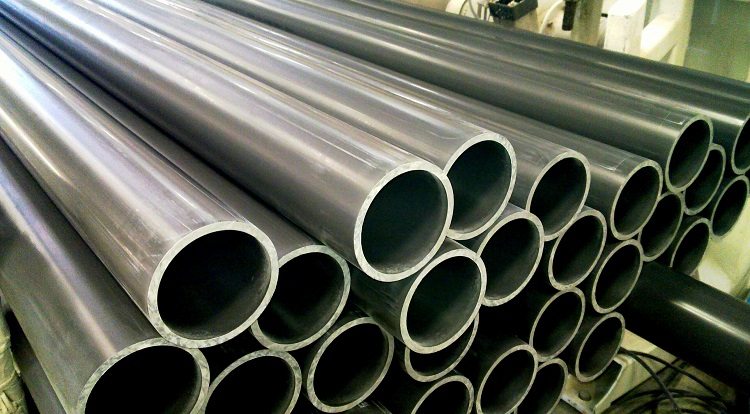
The properties of polyethylene pipes allow them to operate for a long time without replacement or repair
Helpful information! Even the initial strength of HDPE does not negate for each grade and type of product testing on such characteristics as resistance to high temperatures, rupture, and increased pressure.
Design features
The diameter and wall thickness have a direct impact on the scope, properties and choice of method for connecting low-pressure polyethylene pipes. The SDR index in the marking indicates the ratio of these parameters of these products and their strength characteristics. The table below shows the permissible pressure of the working medium for low-pressure polyethylene pipes with a diameter of 10≤D ≤1600 mm and a wall thickness of 2≤S≤60 mm. Having studied these data, you can choose the optimal connection of HDPE pipes.
Table 1
| Pressure for PE-100, atmosphere |
20 | 16 | 12,5 | 9,5 | 8 | 6 | 4 |
| Pressure for PE-80, atmosphere |
16 | 12,5 | 10 | 7,5 | 6 | 5 | 3,2 |
| External diameter pipes, millimeters |
SDR9 | SDR11 | SDR13-14 | SDR17 | SDR21 | SDR26 | SDR41 |
| 400 | 44,7 | 36,3 | 29,4 | 23,7 | 19,1 | 15,3 | 9,8 |
| 2315 | 35,2 | 28,6 | 23,2 | 18,7 | 15 | 21,1 | 7,7 |
| 225 | 25,2 | 20,5 | 16,6 | 13,4 | 10,8 | 8,6 | 5,5 |
| 160 | 17,9 | 14,6 | 11,8 | 9,5 | 7,7 | 6,2 | 4 |
| 90 | 10,1 | 8,2 | 6,7 | 5,4 | 4,3 | 3,5 | 2,2 |
| 75 | 8,4 | 6,8 | 5,6 | 4,5 | 3,6 | 2,9 | 2 |
| 63 | 7,1 | 5,8 | 4,7 | 3,8 | 3 | 2,5 | — |
| 50 | 5,6 | 4,6 | 3,7 | 3 | 2,4 | 2 | — |
| 40 | 4,5 | 3,7 | 3 | 2,4 | 2 | — | — |
| 32 | 3,6 | 3 | 2,4 | 2 | — | — | — |
| 20 | 2,3 | 2 | — | — | — | — | — |
How do polyethylene pipes connect
This process largely depends on the purpose of the pipeline being created and can be performed in two ways. Limitations also impose the properties of the material itself. In other words, for joining polyethylene pipes, technological methods should be used that differ from those that are traditionally used when working with metal products.
One-piece connection. It is formed if it is not intended to disassemble the system during operation. To implement this method, a welding machine is used: preheated pipes are butt welded. But not all homeowners have such unit. And buying it may not be practical if you are not supposed to do this work in the foreseeable future. The question naturally arises, how are HDPE pipes connected in this case? Household craftsmen can use electrofusion welding. In this embodiment, a strong connection is formed as follows: the ends of the pipes are heated to the melting temperature, as a result of which the material is mixed, and after cooling, a reliable tight joint is formed.
Helpful advice! But this method has one serious drawback - the high cost of the electrofusion coupling. If the volume of work expected to be completed is large enough and you are looking for an option how HDPE pipes are connected under this condition with the lowest material costs, choose resistance welding.
Detachable connection. This method does not provide for the use of welding, so if necessary, the pipeline can be dismantled without cutting its elements. Detachable joints of polyethylene pipes are of the following types:
- flanged or fitting. For them, fasteners of a special design are used;
- bell-shaped. They are performed using seals made of elastic materials.
The assembly of pipelines by any of these methods does not require the use of specific devices and tools. In particular, for connecting HDPE pipes with fittings, it is enough to have at their disposal a simple key. With its help, the clamping nuts present on these parts will be twisted and unscrewed.
Features of contact (butt) welding
This is one of the most common methods for connecting polyethylene pipes. When performing it, the ends of the welded products must be fixed in special clamps. These latches are located on common rails. Then, the miter operation is carried out using certain saws. After that, the processed ends of the pipes are heated using an electric heater. This procedure stops when the polyethylene becomes sufficiently viscous and suitable for compression under the action of hydraulics. The penetration of molten parts into each other at the molecular level provides a stable and tight joint of HDPE pipes.
Resistance welding retains sufficient flexibility of the pipeline without compromising its strength. And the quality of the connection depends on the category of equipment used. The end result will be better, the more opportunities the welding machine has to control the heating and melting processes of polyethylene. If you do not know how the PND pipe is connected by resistance welding, the following instructions will come in handy:
- Check the geometry of each pipe. To ensure a snug fit between the sections, their edges should be smoothed and trimmed.
- Correctly place the ends of the joined products in the welding machine. To do this, center their cross sections on the same axis.
- Insert a heating element between the edges and apply voltage to it by pressing the corresponding button on the device. After that, the ends of the pipes will begin to melt.
- Remove the heating plate and press the ends together with some force to each other. Keep under pressure until they have completely cooled. In this case, molten polyethylene is squeezed out between the welded pipes. Hardened, it forms a weld.
Machines for this type of welding are mechanical and hydraulic. The latter are considered professional equipment and require experience in such work.
Important! The implementation of these actions requires a certain qualification, since they must be carried out quickly and accurately with the mandatory observance of the rules of technology.
Connection pipes HDPE fittings
Today, there are several ways to connect polyethylene pipes without welding. But the most widespread flange. However, the application of this method for pipes of small diameter (up to 50 millimeters) is economically disadvantageous. In this case, experts recommend giving preference to the connection of HDPE pipes with compression fittings. These parts consist of 5 elements:
- a housing equipped with a restrictor for introducing pipes;
- locking nut with internal thread;
- crimp rings. It prevents the change in pipe diameter;
- sealing rubber gaskets;
- bushings. It is designed to fix the rubber gasket.
The following types are used to realize the compression connection of polyethylene pipes fittings:
- tee;
- crosspiece;
- coupling;
- saddle branch;
- stub;
- challenge.
Using such compounds for polyethylene pipes, the creation of combined highways is allowed.
For example, crimp couplings are widely used when replacing segments of steel pipelines with polymer ones. The service life of HDPE pipes largely depends on the quality of the joints.
To connect polyethylene pipes with fittings, it is not necessary to have special knowledge of a plumber or a welder. The work must be performed as follows:
- mark the place of the cut;
- cut the pipeline at a right angle;
- align the free ends of the pipes, achieving a perfectly round section;
- push the pipeline into the fitting body to the maximum, being guided by the mark;
- at the final stage, tighten the union nut without excessive force.
When choosing a method for connecting HDPE pipes, the following factors must be taken into account: the most reliable and durable is the welded technology. But compression fitting easier to maintain.
